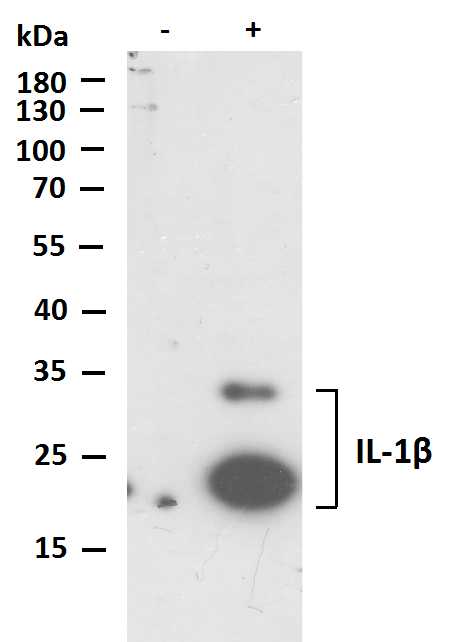IL-1β (PTR2541) mouse mAb
- Catalog No.:YM4682
- Applications:WB;IF;ELISA
- Reactivity:Human;Mouse;Rat;
- Target:
- IL-1β
- Fields:
- >>Antifolate resistance;>>MAPK signaling pathway;>>Cytokine-cytokine receptor interaction;>>NF-kappa B signaling pathway;>>Necroptosis;>>Osteoclast differentiation;>>Toll-like receptor signaling pathway;>>NOD-like receptor signaling pathway;>>Cytosolic DNA-sensing pathway;>>C-type lectin receptor signaling pathway;>>Hematopoietic cell lineage;>>IL-17 signaling pathway;>>Th17 cell differentiation;>>TNF signaling pathway;>>Inflammatory mediator regulation of TRP channels;>>Non-alcoholic fatty liver disease;>>AGE-RAGE signaling pathway in diabetic complications;>>Alcoholic liver disease;>>Type I diabetes mellitus;>>Alzheimer disease;>>Prion disease;>>Pathways of neurodegeneration - multiple diseases;>>Pathogenic Escherichia coli infection;>>Shigellosis;>>Salmonella infection;>>Pertussis;>>Legionellosis;>>Yersinia infection;>>Leishmaniasis;>>Chagas disease;>>African trypanosomiasis;>>Malaria;>>Amoebiasis;>>Tuberculosis;>>Measles;>>Human cytomegalovirus infection;>>Influenza A;>>Herpes simp
- Gene Name:
- IL1B IL1F2
- Protein Name:
- Interleukin-1 beta (IL-1 beta) (Catabolin)
- Human Gene Id:
- 3553
- Human Swiss Prot No:
- P01584
- Mouse Gene Id:
- 16176
- Mouse Swiss Prot No:
- P10749
- Rat Swiss Prot No:
- Q63264
- Immunogen:
- Synthesized peptide derived from human IL-1β AA range: 150-250
- Specificity:
- This antibody detects endogenous levels of IL-1β protein.
- Formulation:
- PBS, 50% glycerol, 0.05% Proclin 300, 0.05%BSA
- Source:
- Mouse, Monoclonal/IgG1, kappa
- Dilution:
- WB 1:500-2000. IF 1:100-500. ELISA 1:1000-5000
- Purification:
- Protein G
- Storage Stability:
- -15°C to -25°C/1 year(Do not lower than -25°C)
- Other Name:
- Interleukin-1 beta (IL-1 beta) (Catabolin)
- Molecular Weight(Da):
- 31kD
- Observed Band(KD):
- 31kD,18kD
- Background:
- interleukin 1 beta(IL1B) Homo sapiens The protein encoded by this gene is a member of the interleukin 1 cytokine family. This cytokine is produced by activated macrophages as a proprotein, which is proteolytically processed to its active form by caspase 1 (CASP1/ICE). This cytokine is an important mediator of the inflammatory response, and is involved in a variety of cellular activities, including cell proliferation, differentiation, and apoptosis. The induction of cyclooxygenase-2 (PTGS2/COX2) by this cytokine in the central nervous system (CNS) is found to contribute to inflammatory pain hypersensitivity. This gene and eight other interleukin 1 family genes form a cytokine gene cluster on chromosome 2. [provided by RefSeq, Jul 2008],
- Function:
- domain:The similarity among the IL-1 precursors suggests that the amino ends of these proteins serve some as yet undefined function.,function:Produced by activated macrophages, IL-1 stimulates thymocyte proliferation by inducing IL-2 release, B-cell maturation and proliferation, and fibroblast growth factor activity. IL-1 proteins are involved in the inflammatory response, being identified as endogenous pyrogens, and are reported to stimulate the release of prostaglandin and collagenase from synovial cells.,online information:Interleukin-1 entry,online information:The Singapore human mutation and polymorphism database,similarity:Belongs to the IL-1 family.,subcellular location:The lack of a specific hydrophobic segment in the precursor sequence suggests that IL-1 is released by damaged cells or is secreted by a mechanism differing from that used for other secretory proteins.,subunit:Mono
- Subcellular Location:
- 0
- Expression:
- Expressed in activated monocytes/macrophages (at protein level).
Crocetin inhibits choroidal neovascularization in both in vitro and in vivo models EXPERIMENTAL EYE RESEARCH Caixia Wang WB Mouse retina tissue,choroid tissue,sclera tissue
Sinapic Acid Attenuates Chronic DSS-Induced Intestinal Fibrosis in C57BL/6J Mice by Modulating NLRP3 Inflammasome Activation and the Autophagy Pathway ACS Omega Wan-Ying Li WB Mouse colon tissue
Sinensetin, a polymethoxyflavone from citrus fruits, ameliorates LPS-induced acute lung injury by suppressing Txnip/NLRP3/Caspase-1/GSDMD signaling-mediated inflammatory responses and pyroptosis Food & Function Zaibin Xu WB Mouse lung tissue RAW264.7 cell
Targeting TANK-binding kinase 1 attenuates painful diabetic neuropathy via inhibiting microglia pyroptosis Cell Communication and Signaling Liao Qinming WB Mouse spinal cord tissue
Neuroprotective effects of total phenolics from Hemerocallis citrina Baroni leaves through the PI3K/AKT pathway Frontiers in Pharmacology Jia Yanjun WB Rat PC12 cell
α-amanitin induce inflammatory response by activating ROS/NF-κB-NLRP3 signaling pathway in human hepatoma HepG2 cells CHEMOSPHERE Zhiyong Zhao WB Human HepG2 cell
- June 19-2018
- WESTERN IMMUNOBLOTTING PROTOCOL
- June 19-2018
- IMMUNOHISTOCHEMISTRY-PARAFFIN PROTOCOL
- June 19-2018
- IMMUNOFLUORESCENCE PROTOCOL
- September 08-2020
- FLOW-CYTOMEYRT-PROTOCOL
- May 20-2022
- Cell-Based ELISA│解您多样本WB检测之困扰
- July 13-2018
- CELL-BASED-ELISA-PROTOCOL-FOR-ACETYL-PROTEIN
- July 13-2018
- CELL-BASED-ELISA-PROTOCOL-FOR-PHOSPHO-PROTEIN
- July 13-2018
- Antibody-FAQs
- Products Images

- Various whole cell lysates were separated by 10% SDS-PAGE, and the membrane was blotted with anti-IL-1β(PTR2541) antibody. The HRP-conjugated Goat anti-Mouse IgG(H + L) antibody was used to detect the antibody. Lane 1: Untreated THP-1 Lane 2: THP-1 treated with LPS(100ng/ml) for 3h



